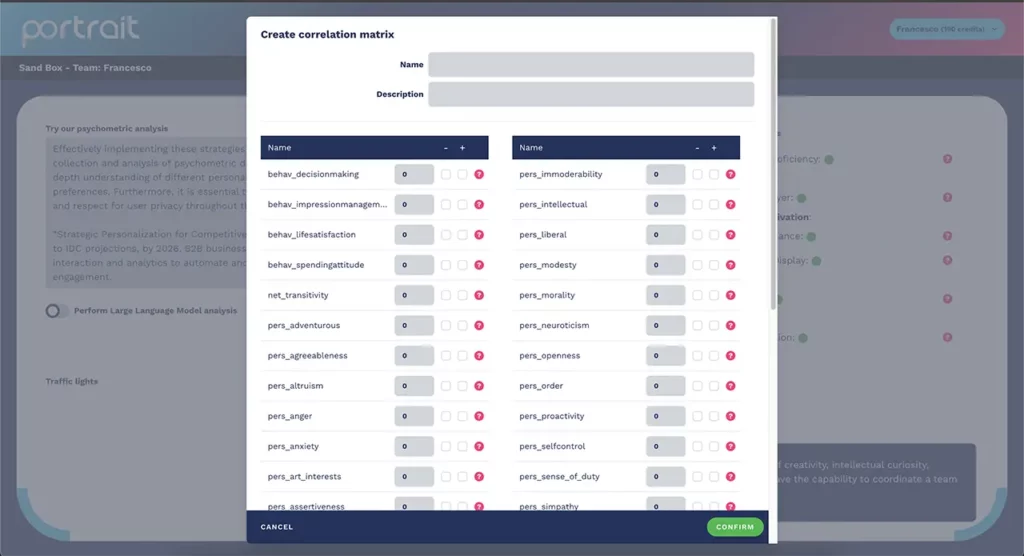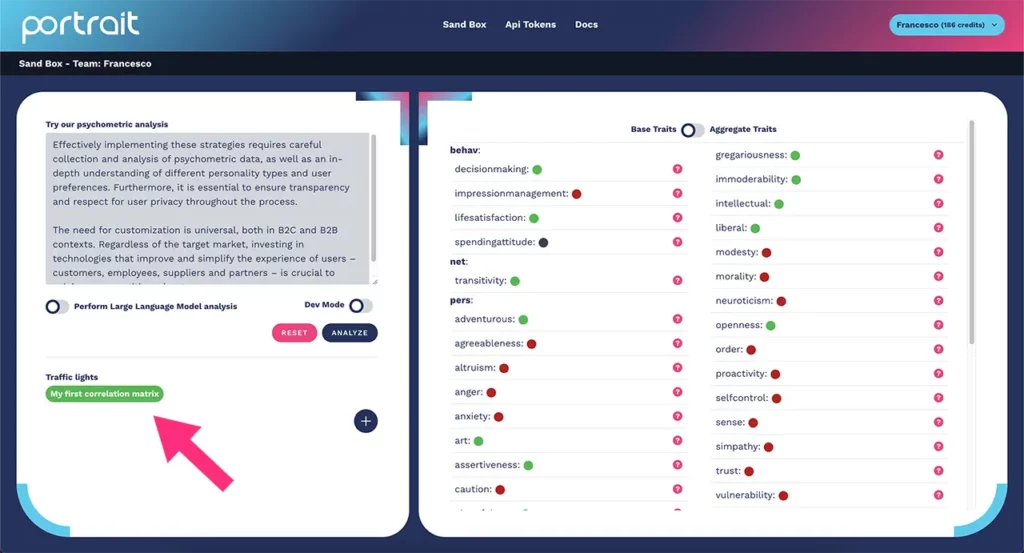Psychometric correlation matrix are tools used to analyze the relationships between variables measured through psychological tests or questionnaires. These matrices show the correlation coefficients between different variables, allowing psychologists and researchers to better understand how different characteristics or traits influence each other.
Psychometric correlation matrix in portrait psychometric profiling
With Portrait it is possible to create a correlation matrix (traffic lights) through the dedicated interface, as shown in the figure below:

Correlations can be positive, negative or zero, indicating the type and intensity of the relationship between two variables. For example, a positive correlation between two traits suggests that they tend to increase or decrease together, while a negative correlation indicates that they vary in opposite directions.
Correlation matrixes are often used in the construction and validation of psychometric instruments and psychological profiles and in scientific research to better understand the structure of psychological traits and their interconnections. This analysis can also be used in contexts such as marketing campaigns, communication, sales, personnel recruitment, professional orientation, psychological evaluation and in many other cases such as, the tendency to churn, risk of insolvency of a policy insurance, etc…
Psychometric correlation matrix traffic lights
With Portrait you can create “traffic-light indicators” that will turn green when your profiled users have the characteristics you identified in the correlation matrix (see the chapter of the documentation dedicated to the creation of traffic lights).

Where to get the data to form your matrix
You have 2 ways to create your own correlation matrix:
Use data in your possession
You can proceed with various profiling of your database and see what psychometric traits your users have in common.
Studies in psychology
There are many psychology studies where it is possible to recover data about the psychometric traits belonging to a certain type of user.
CORRELATION MATRICES, PSYCHOMETRIC PROFILE, VALUES, WEIGHTS AND EXAMPLES
What is a psychometric profile?
A psychometric profile is like a portrait of a person’s personality, created through assessments and tests that measure various psychological traits.
What is a correlation matrix?
Think of the correlation matrix as a large table where each row and column represents a different personality trait.
What is the purpose of the correlation matrix?
It is used to see how each personality trait interacts with the others and contributes to the overall profile.
Matrix Values (-1 to +1)
Signs (+ and -) and weights (-1 to +1):
Imagine that we are giving a score or weight to each personality trait. A value of:
+1 means that the trait is strongly present in a positive sense (contributes a lot).
-1 means that the trait is strongly present in a negative sense (does not contribute much or is contrary).
0 means that the trait has no effect.
How It Works in Practice
Assigning Weights and Signs:
Now, for each personality trait, we decide if this trait is important and in what sense (positive or negative). Then, we assign a weight with a sign:
Positive weight (+): If the trait contributes positively.
Negative weight (-): If the trait contributes negatively.
Calculating the overall profile:
When we perform a profiling, we multiply the value of each trait by the weight we assigned to it and consider the sign (positive or negative). Then we add all these values produced.
Example
Let’s make an example to clarify:
Imagine that we are looking at three personality traits: Sociability, Assertiveness and Anxiety.
We give Sociability a weight of +0.8, Assertiveness a weight of +0.6 and Anxiety a weight of -0.5 (because anxiety could contribute negatively to general well-being).
If a person has these values:
Sociability = 0.7
Assertiveness = 0.5
Anxiety = 0.9
The sum will be:
(0.7 * 0.8) + (0.5 * 0.6) + (0.9 * -0.5)
= 0.56 + 0.3 – 0.45
= 0.41
So, the final result of 0.41 gives us an idea of how the combined personality traits of this individual add up.
In Summary
Whenever we perform a profiling, we apply the correlation matrix to get a numerical understanding of how the various personality characteristics of the individual combine. This helps us see the bigger picture in a simple and measurable way.
NB: Contact us if you need immediate support in creating your correlation matrix.
